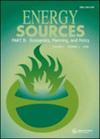Inclusive growth and the sophisticated influence of carbon emissions, renewable energy, and financial development: An introspective analysis of Africa
IF 2.2
4区 工程技术
Q3 ENERGY & FUELS
Energy Sources Part B-Economics Planning and Policy
Pub Date : 2022-07-28
DOI:10.1080/15567249.2022.2099038
引用次数: 0
Abstract
ABSTRACT This study investigates how inclusive growth is affected by carbon emission, renewable energy, and the new financial development index using 48 African countries categorized into low-income countries (LIC) and middle-income countries (MIC) spanning from 2000 to 2018. Bearing in mind the presence of residual cross-sectional reliance and heterogeneity in a panel data settings, the study employed robust estimations econometric approaches which includes the Augmented Mean group (AMG), Driscoll-Kraay (DK) standard errors method together with the Correlated Effects Mean Group (CCEMG) technique. The study’s outcomes from the mentioned approaches showed that; carbon emission positively affects inclusive growth in aggregate African panel, and LIC but not in MIC panels correspondingly. Furthermore, renewable energy significantly mitigates inclusive growth in LIC group African nations, but not significant in Africa as a whole or in MIC country grouping. Financial development is homogeneously positive and significant, with inclusive growth across all panels of African economies. The outlined outcomes were also confirmed by the Generalized Method of Moments (System-GMM). Based on the outlined study preferably suggest that carbon emission in LIC must be focused on attracting investments with low carbon footprints. On renewable energy, it is further recommended that both LIC and MIC should sticks to the African Renewable Energy Initiative.包容性增长与碳排放、可再生能源和金融发展的复杂影响:对非洲的内省分析
本研究以2000年至2018年48个被划分为低收入国家(LIC)和中等收入国家(MIC)的非洲国家为研究对象,探讨了包容性增长如何受到碳排放、可再生能源和新金融发展指数的影响。考虑到面板数据设置中存在剩余横截面依赖和异质性,该研究采用了稳健估计计量经济学方法,包括增强平均组(AMG), Driscoll-Kraay (DK)标准误差方法以及相关效应平均组(CCEMG)技术。上述方法的研究结果表明;碳排放对总体非洲面板的包容性增长有积极影响,对低收入国家面板的包容性增长有积极影响,而对中等收入国家面板的包容性增长没有积极影响。此外,可再生能源显著减缓了低收入国家集团非洲国家的包容性增长,但在整个非洲或中等收入国家集团中并不显著。金融发展同样是积极而重要的,非洲各经济体都实现了包容性增长。这些结果也被广义矩量法(System-GMM)所证实。根据概述的研究,最好建议低碳国家的碳排放必须侧重于吸引低碳足迹的投资。在可再生能源方面,进一步建议LIC和MIC都应坚持非洲可再生能源倡议。
本文章由计算机程序翻译,如有差异,请以英文原文为准。
求助全文
约1分钟内获得全文
求助全文
来源期刊

Energy Sources Part B-Economics Planning and Policy
ENERGY & FUELS-
CiteScore
6.80
自引率
12.80%
发文量
42
审稿时长
6-12 weeks
期刊介绍:
12 issues per year
Abstracted and/or indexed in: Applied Science & Technology Index; API Abstracts/Literature; Automatic Subject Index Citation; BIOSIS Previews; Cabell’s Directory of Publishing Opportunities in Economics and Finance; Chemical Abstracts; CSA Aquatic Science & Fisheries Abstracts; CSA Environmental Sciences & Pollution Management Database; CSA Pollution Abstracts; Current Contents/Engineering, Technology & Applied Sciences; Directory of Industry Data Sources; Economic Abstracts; Electrical and Electronics Abstracts; Energy Information Abstracts; Energy Research Abstracts; Engineering Index Monthly; Environmental Abstracts; Environmental Periodicals Bibliography (EPB); International Abstracts in Operations Research; Operations/Research/Management Science Abstracts; Petroleum Abstracts; Physikalische Berichte; and Science Citation Index.
Taylor & Francis make every effort to ensure the accuracy of all the information (the "Content") contained in our publications. However, Taylor & Francis, our agents, and our licensors make no representations or warranties whatsoever as to the accuracy, completeness, or suitability for any purpose of the Content. Any opinions and views expressed in this publication are the opinions and views of the authors, and are not the views of or endorsed by Taylor & Francis. The accuracy of the Content should not be relied upon and should be independently verified with primary sources of information. Taylor & Francis shall not be liable for any losses, actions, claims, proceedings, demands, costs, expenses, damages, and other liabilities whatsoever or howsoever caused arising directly or indirectly in connection with, in relation to, or arising out of the use of the Content. Terms & Conditions of access and use can be found at http://www.tandfonline.com/page/terms-and-conditions .
 求助内容:
求助内容: 应助结果提醒方式:
应助结果提醒方式:


